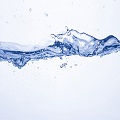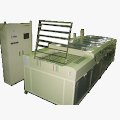Cleaning machine
Table of contents (Click to move to the lower part of this page)
Definition of “Cleaning”
Cleaning is a process which selectively removes targeted substances from the surface of a workpiece. Ideal cleaning method, chemicals, and cleaning time are decided by the material of a workpiece or the property of the dirt.
Purpose/ method of cleaning
Purpose of a cleaning machine is to wash off grease or particles attached on the surface of a workpiece. Shower cleaning method and submerged jet cleaning method are two of the representative cleaning methods.
“Ultrasonic cleaning machine” using ultrasonic wave and “Brush-type cleaning machine” directly brushing off the dirt from a workpiece are adopted to remove the dirt which cannot be cleaned off simply by showers.
Besides the above there are also other methods such as bubble type cleaning method, etc.
Shower cleaning/ Spray cleaning
Shower cleaning is a method of cleaning by spraying cleaning solvent (cleaning solution) onto the workpieces.
“High-pressure spray cleaning” is a method in which cleaning process is performed through raising the pressure of spray jet to a high level.
“Two-fluid spray cleaning” is a method in which cleaning effect is enhanced with liquid atomization through producing liquid and compressed air simultaneously. Continuous shock between atomized cleaning liquid and dirt can raise the cleaning effect to the level higher than that of high-pressure spray cleaning.
Ultrasonic cleaning
There are two methods for ultrasonic cleaning. “Submersible ultrasonic cleaning” is a method in which ultrasonic transducers are installed inside cleaning tanks.
Dirt on the workpiece surface is removed through submerging the workpiece into cleaning liquid, where ultrasonic waves are transmitted to the workpiece. The other method “Ultrasonic shower cleaning” provides another way of cleaning by joining ultrasonic waves to the cleaning solvent ejected from shower nozzles.
During the cleaning process cavitation phenomenon occurs, where very small-sized bubbles are generated, and with the shock caused by these bubbles collapsing, the dirt is more easily to peel off so that cleaning effect is enhanced.
Both methods use ultrasonic waves to make dirt peel off more easily and both methods are able to enhance cleaning effect. Considering that output and frequencies of ultrasonic waves differ depending on the property of dirt, sufficient verification is necessary.
Brush-type cleaning
Brush-type cleaning method removes dirt by directly pressing the brush (brush roller) against workpieces.
Physical contact to the dirt brings high cleaning effect. However, this cleaning method is under the control of workpiece material and use conditions considering that the brush also touches the workpieces directly.
It is essential to choose the right brush given that cleaning effect and quality of the processed workpieces are determined by shape and material of the brush.
Degreasing
Degreasing is a method to clean off grease with cleaning solution such as alkaline inorganic acid or organic solvent. With its high grease-dissolving capability, sufficient degreasing cleaning effect can be achieved.
On the other hand, since organic solvent may affect materials such as rubbers or plastics, material selection in consideration of cleaning solution is crucial for fabricating a cleaning machine.
Cleaning machine fabrication records
NSC has a variety of records for cleaning machines from small type to large type.
“Cleaning machine with raising mechanism” in the last photograph below has changed the way of unloading workpieces for operators. In the past operators had to take off the workpieces from the machine with the workpieces lying on conveyance rollers, but now with this “raising mechanism” attached, operators are able to take off the workpieces from the machine after the workpieces are raised up. By utilizing this mechanism, risk of breakage is reduced.
We do not simply fabricate the cleaning machine only according to what is told by the customers, but instead we pay attention to what troubles our customers and endeavor to fabricate a machine with extra value.

Cleaning machine with raising mechanism
(Workpiece size: 730×920mm)

Medium sized cleaning machine in individual process type
(Workpiece size: 400×500mm)

Large sized cleaning machine in individual process type
(Workpiece size: 1500×1850mm)

Medium sized cleaning machine
(Workpiece size: 400×500mm)

Brush-type cleaning machine
(Workpiece size: 730×920mm)

Small-sized cleaning machine
(Workpiece size: 200×200mm)
Specification examples in our machine supply records
|
Item
|
Fabrication record
|
|---|---|
| Material of work |
Glass, sheet metal, metal wire
|
| Chemicals mainly used |
Water, alkaline cleaning solvent, neutral cleaning solvent
|
| Standard delivery time |
3 months
|
| Safety measure |
Interlocks at each spot
|
| Operation system |
Automatic operation
|
| Control system |
PLC control
|
| System standard |
JIS, Japanese Industrial Standard
|
| Options |
Brush-type cleaning, chemical cleaning, wire winding mechanism, glass substrate raising mechanism
|
Features
Our machines clean the surface of a workpiece individually.
The machines remove grease or particles from the surface of a workpiece.
We provide design & fabrication in accordance with customers’ purpose (options such chemical cleaning, brush-type cleaning, two-fluid nozzle cleaning, ultrasonic cleaning, and more).













